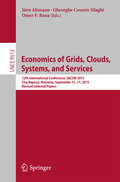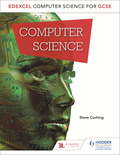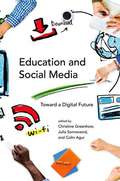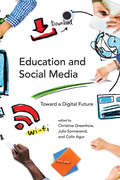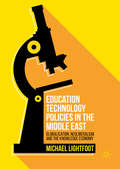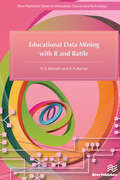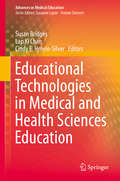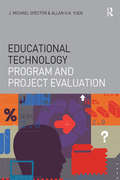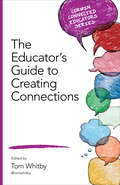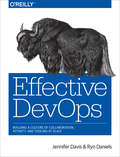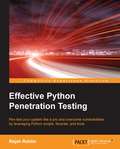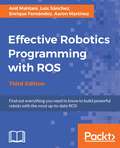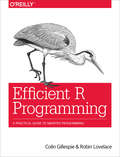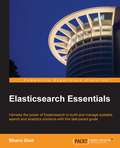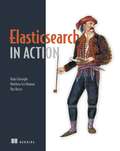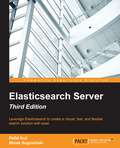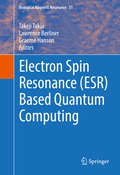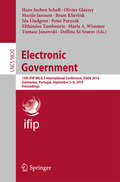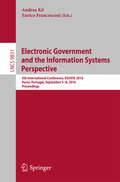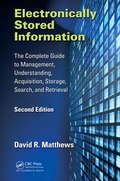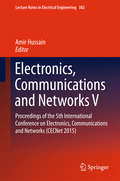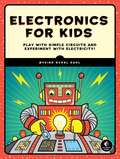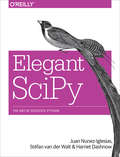- Table View
- List View
Economics of Grids, Clouds, Systems, and Services
by Jörn Altmann Gheorghe Cosmin Silaghi Omer F. RanaThis book constitutes the refereed proceedings of the 12th International Conference on Economics of Grids, Clouds, Systems, and Services, GECON 2015, held in Cluj-Napoca, Romania, in September 2015. The 11 revised full papers and 10 paper-in-progress presented were carefully reviewed and selected from 38 submissions. The presentation sessions that have been set up are: resource allocation, service selection in clouds, energy conservation and smart grids, applications: tools and protocols, community networks and legal and socio-economic aspects.
Edexcel Computer Science for GCSE Student Book
by Steve CushingBuild student confidence and ensure successful progress through GCSE Computer Science. Our expert author provides insight and guidance to meet the demands of the new Edexcel specification, with challenging tasks and activities to test the computational skills and knowledge required completing the exams and the non-examined assessment.- Builds students' knowledge and confidence through detailed topic coverage and explanation of key points to match important Edexcel concepts- Develops computational thinking skills with practice exercises and problem-solving tasks- Ensures progression through GCSE with regular assessment questions, that can be developed with supporting Dynamic Learning digital resources- Instils a deeper understanding and awareness of computer science, and its applications and implications in the wider world
Education and Social Media: Toward a Digital Future
by Colin Agur Christine Greenhow Julia SonnevendHow are widely popular social media such as Facebook, Twitter, and Instagram transforming how teachers teach, how kids learn, and the very foundations of education? What controversies surround the integration of social media in students' lives? The past decade has brought increased access to new media, and with this new opportunities and challenges for education. In this book, leading scholars from education, law, communications, sociology, and cultural studies explore the digital transformation now taking place in a variety of educational contexts. The contributors examine such topics as social media usage in schools, online youth communities, and distance learning in developing countries; the disruption of existing educational models of how knowledge is created and shared; privacy; accreditation; and the tension between the new ease of sharing and copyright laws. Case studies examine teaching media in K--12 schools and at universities; tuition-free, open education powered by social media, as practiced by the University of the People; new financial models for higher education; the benefits and challenges of MOOCS (Massive Open Online Courses); social media and teacher education; and the civic and individual advantages of teens' participatory play.ContributorsColin Agur, Jack M. Balkin, Valerie Belair-Gagnon, danah boyd, Nicholas Bramble, David Buckingham, Chris Dede, Benjamin Gleason, Christine Greenhow, Daniel J. H. Greenwood, Jiahang Li, Yite John Lu, Minhtuyen Mai, John Palfrey, Ri Pierce-Grove, Adam Poppe, Shai Reshef, Julia Sonnevend, Mark Warschauer
Education and Social Media: Toward a Digital Future (The John D. and Catherine T. MacArthur Foundation Series on Digital Media and Learning)
by Christine Greenhow Julia Sonnevend Colin AgurLeading scholars from a variety of disciplines explore the future of education, including social media usage, new norms of knowledge, privacy, copyright, and MOOCs.How are widely popular social media such as Facebook, Twitter, and Instagram transforming how teachers teach, how kids learn, and the very foundations of education? What controversies surround the integration of social media in students' lives? The past decade has brought increased access to new media, and with this new opportunities and challenges for education. In this book, leading scholars from education, law, communications, sociology, and cultural studies explore the digital transformation now taking place in a variety of educational contexts. The contributors examine such topics as social media usage in schools, online youth communities, and distance learning in developing countries; the disruption of existing educational models of how knowledge is created and shared; privacy; accreditation; and the tension between the new ease of sharing and copyright laws. Case studies examine teaching media in K–12 schools and at universities; tuition-free, open education powered by social media, as practiced by the University of the People; new financial models for higher education; the benefits and challenges of MOOCS (Massive Open Online Courses); social media and teacher education; and the civic and individual advantages of teens' participatory play.ContributorsColin Agur, Jack M. Balkin, Valerie Belair-Gagnon, danah boyd, Nicholas Bramble, David Buckingham, Chris Dede, Benjamin Gleason, Christine Greenhow, Daniel J. H. Greenwood, Jiahang Li, Yite John Lu, Minhtuyen Mai, John Palfrey, Ri Pierce-Grove, Adam Poppe, Shai Reshef, Julia Sonnevend, Mark Warschauer
Education Technology Policies in the Middle East
by Michael LightfootThis book explores the potential educational technologies have for transforming education in the Middle East. Although technology has increasingly become a part of classrooms around the globe over recent decades, its application in classrooms in the MENA region remains underused and this book draws on a case study from the Arabian Gulf to examine the beneficial impact technologies have on teaching and learning. The book identifies the many social and cultural pressures that prevent government technology policies to be implemented in the way that the international community would find recognisable and acceptable and how education policy from the Global North is transplanted into a separate context without considering the different requirements. The study seeks to address the ways in which educational technology policy in government schools plays a part in the enactment of education reforms and how government policy aspirations are played out in practice. iv>
Educational Data Mining with R and Rattle
by R.S. Kamath R.K. KamatEducational Data Mining (EDM) is one of the emerging fields in the pedagogy and andragogy paradigm, it concerns the techniques which research data coming from the educational domain. EDM is a promising discipline which has an imperative impact on predicting students' academic performance. It includes the transformation of existing, and the innovation of new approaches derived from multidisciplinary spheres of influence such as statistics, machine learning, psychometrics, scientific computing etc.An archetype that is covered in this book is that of learning by example. The intention is that reader will easily be able to replicate the given examples and then adapt them to suit their own needs of teaching-learning. The content of the book is based on the research work undertaken by the authors on the theme "Mining of Educational Data for the Analysis and Prediction of Students' Academic Performance". The basic know-how presented in this book can be treated as guide for educational data mining implementation using R and Rattle open source data mining tools. .Technical topics discussed in the book include:• Emerging Research Directions in Educational Data Mining• Design Aspects and Developmental Framework of the System• Model Development - Building Classifiers• Educational Data Analysis: Clustering Approach
Educational Psychology and the Internet
by Michael GlassmanThe first comprehensive, research-based textbook on Internet-infused education, Educational Psychology and the Internet offers students an accessible guide to important issues in the field. Michael Glassman begins with an overview of the history that traces the evolution of the Internet and its significance for education. He outlines the current state of research, clearly defining terms that students will need to discuss larger concepts, such as hypertext and cyberspace. The second part of the book explores the practical applications of this research, which range from the individual-oriented to the generalized, including massive open online courses (MOOCs), open educational resources, and augmented reality. Key issues that affect teachers and students today, such as Net Neutrality and Creative Commons and Open Source licenses, are explained in straightforward terms, and often-overlooked differences - for example, between course management systems and learning management systems, and between blogs, social networking sites, and short messaging systems - are highlighted.
Educational Technologies in Medical and Health Sciences Education
by Susan Bridges Lap Ki Chan Cindy E. Hmelo-SilverThis evidence-packed guide explores the growing importance of new technologies and situated learning in the vanguard of medical and health sciences education, backed by real-world clinical applications. Its dual emphasis on problem-based learning (PBL) and applied learning is reflected in the range of author perspectives, from understanding how technologies engage learners to implications for program design. Innovations covered range from wider and more targeted use of mobile devices and electronic medical records to video cases and virtual patients, in clinical contexts from family practice to specialized surgery. At the same time, chapters detail both the necessary hardware for putting these systems into place and the software needed to make them accessible to learners. Among the featured topics: Technology and group processes in PBL: An ethnographic study. What is real? Using problem-based learning in virtual worlds. Are Wikipedia articles reliable learning resources in PBL curricula? Utilizing mobile electronic health records in clinical education. Measuring emotions in medicine: methodological and technological advances within authentic medical learning environments. The deteriorating patient smartphone app: towards serious game design. Medical/health sciences educators and researchers in educational technology will look to Educational Technologies in Medical and Health Sciences Education to pinpoint current and future trends in an ever-important field.
Educational Technology Program and Project Evaluation (Interdisciplinary Approaches to Educational Technology)
by J. Michael Spector Allan H.K. YuenEducational Technology Program and Project Evaluation is a unique, comprehensive guide to the formative and summative evaluation of programs, projects, products, practices and policies involving educational technology. Written for both beginning and experienced evaluators, the book utilizes an integrative, systems-based approach; its practical emphasis on logic models and theories of change will help readers navigate their own evaluation processes to improve interventions and conduct meaningful educational research. Key features include: evidence-based guidelines for constructing and conducting evaluations practical exercises to support the development of knowledge, skills, and program evaluation portfolios a variety of interdisciplinary case studies references and links to pertinent research and resources Using the TELL, ASK, SHOW, DO model first introduced in this series, Educational Technology Program and Project Evaluation provides comprehensive coverage of the concepts, goals, design, implementation, and critical questions imperative to successful technology-enhanced evaluation.
The Educator's Guide to Creating Connections (Corwin Connected Educators Series)
by Tom WhitbyBlogging, social media, and PLN’s made easy! Collectively, we’re all smarter than we are individually. In this expert guide, EdTech leaders help you harness the power of connected collaboration using the Internet and social media. You’ll easily leverage Twitter, Facebook, LinkedIn and beyond for profound professional growth. Use real-world tips and tools to: Master and adapt to 21st Century teaching methodologies Build ongoing technology literacy for you and your students Connect and collaborate with education leaders across the globe Get connected. Get engaged. Use this inspiring, step-by-step manual to expand your personal and professional network today!
The Educator's Guide to Creating Connections (Corwin Connected Educators Series)
by Tom WhitbyBlogging, social media, and PLN’s made easy! Collectively, we’re all smarter than we are individually. In this expert guide, EdTech leaders help you harness the power of connected collaboration using the Internet and social media. You’ll easily leverage Twitter, Facebook, LinkedIn and beyond for profound professional growth. Use real-world tips and tools to: Master and adapt to 21st Century teaching methodologies Build ongoing technology literacy for you and your students Connect and collaborate with education leaders across the globe Get connected. Get engaged. Use this inspiring, step-by-step manual to expand your personal and professional network today!
Effective DevOps: Building a Culture of Collaboration, Affinity, and Tooling at Scale
by Katherine Daniels Jennifer DavisSome companies think that adopting devops means bringing in specialists or a host of new tools. With this practical guide, you'll learn why devops is a professional and cultural movement that calls for change from inside your organization. Authors Katherine Daniels and Jennifer Davis provide several approaches for improving collaboration within teams, creating affinity among teams, promoting efficient tool usage in your company, and scaling up what works throughout your organization's inflection points.Devops stresses iterative efforts to break down information silos, monitor relationships, and repair misunderstandings that arise between and within teams in your organization. By applying the actionable strategies in this book, you can make sustainable changes in your environment regardless of your level within your organization.Explore the foundations of devops and learn the four pillars of effective devopsEncourage collaboration to help individuals work together and build durable and long-lasting relationshipsCreate affinity among teams while balancing differing goals or metricsAccelerate cultural direction by selecting tools and workflows that complement your organizationTroubleshoot common problems and misunderstandings that can arise throughout the organizational lifecycleLearn from case studies from organizations and individuals to help inform your own devops journey
Effective Python Penetration Testing
by Rejah RehimPen test your system like a pro and overcome vulnerabilities by leveraging Python scripts, libraries, and tools About This Book * Learn to utilize your Python scripting skills to pentest a computer system, network, and web-application * Get proficient at the art of assessing vulnerabilities by conducting effective penetration testing * This is the ultimate guide that teaches you how to use Python to protect your systems against sophisticated cyber attacks Who This Book Is For This book is ideal for those who are comfortable with Python or a similar language and need no help with basic programming concepts, but want to understand the basics of penetration testing and the problems pentesters face. What You Will Learn * Write Scapy scripts to investigate network traffic * Get to know application fingerprinting techniques with Python * Understand the attack scripting techniques * Write fuzzing tools with pentesting requirements * Learn basic attack scripting methods * Utilize cryptographic toolkits in Python * Automate pentesting with Python tools and libraries In Detail Penetration testing is a practice of testing a computer system, network, or web application to find weaknesses in security that an attacker can exploit. Effective Python Penetration Testing will help you utilize your Python scripting skills to safeguard your networks from cyberattacks. We will begin by providing you with an overview of Python scripting and penetration testing. You will learn to analyze network traffic by writing Scapy scripts and will see how to fingerprint web applications with Python libraries such as ProxMon and Spynner. Moving on, you will find out how to write basic attack scripts, and will develop debugging and reverse engineering skills with Python libraries. Toward the end of the book, you will discover how to utilize cryptography toolkits in Python and how to automate Python tools and libraries. Style and approach This is an expert's guide to Python with a practical based approach, where each chapter will help you improve your penetration testing skills using Python to become a master pen tester.
Effective Robotics Programming with ROS - Third Edition
by Luis Sanchez Enrique Fernandez Anil Mahtani Aaron MartinezFind out everything you need to know to build powerful robots with the most up-to-date ROS About This Book • This comprehensive, yet easy-to-follow guide will help you find your way through the ROS framework • Successfully design and simulate your 3D robot model and use powerful robotics algorithms and tools to program and set up your robots with an unparalleled experience by using the exciting new features from Robot Kinetic • Use the latest version of gazebo simulator, OpenCV 3.0, and C++11 standard for your own algorithms Who This Book Is For This book is suitable for an ROS beginner as well as an experienced ROS roboticist or ROS user or developer who is curious to learn ROS Kinetic and its features to make an autonomous Robot. The book is also suitable for those who want to integrate sensors and embedded systems with other software and tools using ROS as a framework. What You Will Learn • Understand the concepts of ROS, the command-line tools, visualization GUIs, and how to debug ROS • Connect robot sensors and actuators to ROS • Obtain and analyze data from cameras and 3D sensors • Use Gazebo for robot/sensor and environment simulation • Design a robot and see how to make it map the environment, navigate autonomously, and manipulate objects in the environment using MoveIt! • Add vision capabilities to the robot using OpenCV 3.0 • Add 3D perception capabilities to the robot using the latest version of PCL In Detail Building and programming a robot can be cumbersome and time-consuming, but not when you have the right collection of tools, libraries, and more importantly expert collaboration. ROS enables collaborative software development and offers an unmatched simulated environment that simplifies the entire robot building process. This book is packed with hands-on examples that will help you program your robot and give you complete solutions using open source ROS libraries and tools. It also shows you how to use virtual machines and Docker containers to simplify the installation of Ubuntu and the ROS framework, so you can start working in an isolated and control environment without changing your regular computer setup. It starts with the installation and basic concepts, then continues with more complex modules available in ROS such as sensors and actuators integration (drivers), navigation and mapping (so you can create an autonomous mobile robot), manipulation, Computer Vision, perception in 3D with PCL, and more. By the end of the book, you'll be able to leverage all the ROS Kinetic features to build a fully fledged robot for all your needs. Style and approach This book is packed with hands-on examples that will help you program your robot and give you complete solutions using ROS open source libraries and tools. All the robotics concepts and modules are explained and multiple examples are provided so that you can understand them easily.
Efficient R Programming: A Practical Guide to Smarter Programming
by Robin Lovelace Colin GillespieThere are many excellent R resources for visualization, data science, and package development. Hundreds of scattered vignettes, web pages, and forums explain how to use R in particular domains. But little has been written on how to simply make R work effectively--until now. This hands-on book teaches novices and experienced R users how to write efficient R code.Drawing on years of experience teaching R courses, authors Colin Gillespie and Robin Lovelace provide practical advice on a range of topics--from optimizing the set-up of RStudio to leveraging C++--that make this book a useful addition to any R user's bookshelf. Academics, business users, and programmers from a wide range of backgrounds stand to benefit from the guidance in Efficient R Programming.Get advice for setting up an R programming environmentExplore general programming concepts and R coding techniquesUnderstand the ingredients of an efficient R workflowLearn how to efficiently read and write data in RDive into data carpentry--the vital skill for cleaning raw dataOptimize your code with profiling, standard tricks, and other methodsDetermine your hardware capabilities for handling R computationMaximize the benefits of collaborative R programmingAccelerate your transition from R hacker to R programmer
Elasticsearch Essentials
by Bharvi DixitHarness the power of ElasticSearch to build and manage scalable search and analytics solutions with this fast-paced guide About This Book * New to ElasticSearch? Here's what you need--a highly practical guide that gives you a quick start with ElasticSearch using easy-to-follow examples; get up and running with ElasticSearch APIs in no time * Get the latest guide on ElasticSearch 2.0.0, which contains concise and adequate information on handling all the issues a developer needs to know while handling data in bulk with search relevancy * Learn to create large-scale ElasticSearch clusters using best practices * Learn from our experts--written by Bharvi Dixit who has extensive experience in working with search servers (especially ElasticSearch) Who This Book Is For Anyone who wants to build efficient search and analytics applications can choose this book. This book is also beneficial for skilled developers, especially ones experienced with Lucene or Solr, who now want to learn Elasticsearch quickly. What You Will Learn * Get to know about advanced Elasticsearch concepts and its REST APIs * Write CRUD operations and other search functionalities using the ElasticSearch Python and Java clients * Dig into wide range of queries and find out how to use them correctly * Design schema and mappings with built-in and custom analyzers * Excel in data modeling concepts and query optimization * Master document relationships and geospatial data * Build analytics using aggregations * Setup and scale Elasticsearch clusters using best practices * Learn to take data backups and secure Elasticsearch clusters In Detail With constantly evolving and growing datasets, organizations have the need to find actionable insights for their business. ElasticSearch, which is the world's most advanced search and analytics engine, brings the ability to make massive amounts of data usable in a matter of milliseconds. It not only gives you the power to build blazing fast search solutions over a massive amount of data, but can also serve as a NoSQL data store. This guide will take you on a tour to become a competent developer quickly with a solid knowledge level and understanding of the ElasticSearch core concepts. Starting from the beginning, this book will cover these core concepts, setting up ElasticSearch and various plugins, working with analyzers, and creating mappings. This book provides complete coverage of working with ElasticSearch using Python and performing CRUD operations and aggregation-based analytics, handling document relationships in the NoSQL world, working with geospatial data, and taking data backups. Finally, we'll show you how to set up and scale ElasticSearch clusters in production environments as well as providing some best practices. Style and approach This is an easy-to-follow guide with practical examples and clear explanations of the concepts. This fast-paced book believes in providing very rich content focusing majorly on practical implementation. This book will provide you with step-by-step practical examples, letting you know about the common errors and solutions along with ample screenshots and code to ensure your success.
Elasticsearch in Action
by Roy Russo Radu Gheorghe Matthew Lee HinmanSummaryElasticsearch in Action teaches you how to build scalable search applications using Elasticsearch. You'll ramp up fast, with an informative overview and an engaging introductory example. Within the first few chapters, you'll pick up the core concepts you need to implement basic searches and efficient indexing. With the fundamentals well in hand, you'll go on to gain an organized view of how to optimize your design. Perfect for developers and administrators building and managing search-oriented applications.Purchase of the print book includes a free eBook in PDF, Kindle, and ePub formats from Manning Publications.About the TechnologyModern search seems like magic—you type a few words and the search engine appears to know what you want. With the Elasticsearch real-time search and analytics engine, you can give your users this magical experience without having to do complex low-level programming or understand advanced data science algorithms. You just install it, tweak it, and get on with your work.About the BookElasticsearch in Action teaches you how to write applications that deliver professional quality search. As you read, you'll learn to add basic search features to any application, enhance search results with predictive analysis and relevancy ranking, and use saved data from prior searches to give users a custom experience. This practical book focuses on Elasticsearch's REST API via HTTP. Code snippets are written mostly in bash using cURL, so they're easily translatable to other languages.What's InsideWhat is a great search application?Building scalable search solutionsUsing Elasticsearch with any languageConfiguration and tuningAbout the ReaderFor developers and administrators building and managing search-oriented applications.About the AuthorsRadu Gheorghe is a search consultant and software engineer. Matthew Lee Hinman develops highly available, cloud-based systems. Roy Russo is a specialist in predictive analytics.Table of ContentsPART 1 CORE ELASTICSEARCH FUNCTIONALITYIntroducing ElasticsearchDiving into the functionalityIndexing, updating, and deleting dataSearching your dataAnalyzing your dataSearching with relevancyExploring your data with aggregationsRelations among documentsPART 2 ADVANCED ELASTICSEARCH FUNCTIONALITYScaling outImproving performanceAdministering your cluster
Elasticsearch Server - Third Edition
by Rafal Kuc Marek RogozinskiLeverage Elasticsearch to create a robust, fast, and flexible search solution with ease About This Book * Boost the searching capabilities of your system through synonyms, multilingual data handling, nested objects and parent-child documents * Deep dive into the world of data aggregation and data analysis with ElasticSearch * Explore a wide range of ElasticSearch modules that define the behavior of a cluster Who This Book Is For If you are a competent developer and want to learn about the great and exciting world of ElasticSearch, then this book is for you. No prior knowledge of Java or Apache Lucene is needed. What You Will Learn * Configure, create, and retrieve data from your indices * Use an ElasticSearch query DSL to create a wide range of queries * Discover the highlighting and geographical search features offered by ElasticSearch * Find out how to index data that is not flat or data that has a relationship * Exploit a prospective search to search for queries not documents * Use the aggregations framework to get more from your data and improve your client's search experience * Monitor your cluster state and health using the ElasticSearch API as well as third-party monitoring solutions * Discover how to properly set up ElasticSearch for various use cases In Detail ElasticSearch is a very fast and scalable open source search engine, designed with distribution and cloud in mind, complete with all the goodies that Apache Lucene has to offer. ElasticSearch's schema-free architecture allows developers to index and search unstructured content, making it perfectly suited for both small projects and large big data warehouses, even those with petabytes of unstructured data. This book will guide you through the world of the most commonly used ElasticSearch server functionalities. You'll start off by getting an understanding of the basics of ElasticSearch and its data indexing functionality. Next, you will see the querying capabilities of ElasticSearch, followed by a through explanation of scoring and search relevance. After this, you will explore the aggregation and data analysis capabilities of ElasticSearch and will learn how cluster administration and scaling can be used to boost your application performance. You'll find out how to use the friendly REST APIs and how to tune ElasticSearch to make the most of it. By the end of this book, you will have be able to create amazing search solutions as per your project's specifications. Style and approach This step-by-step guide is full of screenshots and real-world examples to take you on a journey through the wonderful world of full text search provided by ElasticSearch.
Electron Spin Resonance (ESR) Based Quantum Computing
by Takeji Takui Lawrence Berliner Graeme HansonThis book addresses electron spin-qubit based quantum computing and quantum information processing with a strong focus on the background and applications to EPR/ESR technique and spectroscopy. It explores a broad spectrum of topics including quantum computing, information processing, quantum effects in electron-nuclear coupled molecular spin systems, adiabatic quantum computing, heat bath algorithmic cooling with spins, and gateway schemes of quantum control for spin networks to NMR quantum information. The organization of the book places emphasis on relevant molecular qubit spectroscopy. These revolutionary concepts have never before been included in a comprehensive volume that covers theory, physical basis, technological basis, applications, and new advances in this emerging field. Electron Spin Resonance (ESR) Based Quantum Computing, co-edited by leading and renowned researchers Takeji Takui, Graeme Hanson and Lawrence J Berliner, is an ideal resource for students and researchers in the fields of EPR/ESR, NMR and quantum computing. This book also * Explores methods of harnessing quantum effects in electron-nuclear coupled molecular spin systems * Expertly discusses applications of optimal control theory in quantum computing * Broadens the readers' understanding of NMR quantum information processing
Electronic Government: 15th IFIP WG 8.5 International Conference, EGOV 2016, Guimarães, Portugal, September 5-8, 2016, Proceedings (Lecture Notes in Computer Science #9820)
by Hans Jochen Scholl Olivier Glassey Marijn Janssen Bram Klievink Ida Lindgren Peter Parycek Efthimios Tambouris Maria A. Wimmer Tomasz Janowski Delfina Sá SoaresThis book constitutes the refereed proceedings of the 15th IFIP WG 8.5 International Conference on Electronic Government, EGOV 2016, held in Guimaraes, Portugal, in September 2016, in conjunction with the 8th International Conference on eParticipation, ePart 2016. The 24 revised full papers presented were carefully reviewed and selected from 87 submissions. The papers are clustered under the following topical sections: foundations; benchmarking and evaluation; information integration and governance; services; evaluation and public values; EGOV success and failure; governance; social media; engagement; processes; policy-making; trust, transparency and accountability; open government and big/open data; smart government/governance/cities.
Electronic Government and the Information Systems Perspective: 5th International Conference, EGOVIS 2016, Porto, Portugal, September 5-8, 2016, Proceedings (Lecture Notes in Computer Science #9831)
by Andrea Kő Enrico FrancesconiThis book constitutes the refereed proceedings of the 5th International Conference on Electronic Government and the Information Systems Perspective, EGOVIS 2016, held in Porto, Portugal, in September 2016, in conjunction with DEXA 2015. The 22 revised full papers presented together with three invited talk were carefully reviewed and selected from 27 submissions. The papers are organized in the following topical sections: e-government cases - legal issues; e-government cases - technical issues; open data and transparency; knowledge representation and modeling in e-government; intelligent systems in e-government; e-government research and intelligent systems; e-government data and knowledge management; identity management in e-government.
Electronically Stored Information: The Complete Guide to Management, Understanding, Acquisition, Storage, Search, and Retrieval
by David MatthewsAlthough we live in an era in which we are surrounded by an ever-deepening fog of data, few of us truly understand how the data are created, where data are stored, or how to retrieve or destroy data—if that is indeed possible. This book is for all of you, whatever your need or interest. <p><P>Electronically Stored Information: The Complete Guide to Management, Understanding, Acquisition, Storage, Search, and Retrieval, Second Edition explains the reasons you need to know about electronic data. It also gets into great detail about the how, what, when, and where of what is known in legal circles as electronically stored information (ESI). <p><P>With easy-to-understand explanations and guidelines, this book provides the practical understanding you need to effectively manage the complex world of ESI. Whether you are an attorney, judge, paralegal, business manager or owner, or just one of the ever-growing population of computer users, you will benefit from the information presented in this book.
Electronics, Communications and Networks V
by Amir HussainThis book comprises peer-reviewed contributions presented at the 5th International Conference on Electronics, Communications and Networks (CECNet 2015), held in Shanghai, China, 12-15 December, 2015. It includes new multi-disciplinary topics spanning a unique depth and breadth of cutting-edge research areas in Electronic Engineering, Communications and Networks, and Computer Technology. More generally, it is of interest to academics, students and professionals involved in Consumer Electronics Technology, Communication Engineering and Technology, Wireless Communication Systems and Technology, and Computer Engineering and Technology.
Electronics for Kids: Play with Simple Circuits and Experiment with Electricity!
by Oyvind Nydal Dahl<P>Why do the lights in a house turn on when you flip a switch? How does a remote-controlled car move? And what makes lights on TVs and microwaves blink? The technology around you may seem like magic, but most of it wouldn’t run without electricity.Electronics for Kids demystifies electricity with a collection of awesome hands-on projects. <P>In Part 1, you’ll learn how current, voltage, and circuits work by making a battery out of a lemon, turning a metal bolt into an electromagnet, and transforming a paper cup and some magnets into a spinning motor. <P> In Part 2, you’ll make even more cool stuff as you: <br>–Solder a blinking LED circuit with resistors, capacitors, and relays <br>–Turn a circuit into a touch sensor using your finger as a resistor–Build an alarm clock triggered by the sunrise <br>–Create a musical instrument that makes sci-fi sounds. <P>Then, in Part 3, you’ll learn about digital electronics—things like logic gates and memory circuits—as you make a secret code checker and an electronic coin flipper. Finally, you’ll use everything you’ve learned to make the LED Reaction Game—test your reaction time as you try to catch a blinking light!With its clear explanations and assortment of hands-on projects, Electronics for Kids will have you building your own circuits in no time.
Elegant SciPy: The Art of Scientific Python
by Harriet Dashnow Juan Nunez-Iglesias Stéfan van der WaltWelcome to Scientific Python and its community. If you’re a scientist who programs with Python, this practical guide not only teaches you the fundamental parts of SciPy and libraries related to it, but also gives you a taste for beautiful, easy-to-read code that you can use in practice. You’ll learn how to write elegant code that’s clear, concise, and efficient at executing the task at hand.Throughout the book, you’ll work with examples from the wider scientific Python ecosystem, using code that illustrates principles outlined in the book. Using actual scientific data, you’ll work on real-world problems with SciPy, NumPy, Pandas, scikit-image, and other Python libraries.Explore the NumPy array, the data structure that underlies numerical scientific computationUse quantile normalization to ensure that measurements fit a specific distributionRepresent separate regions in an image with a Region Adjacency GraphConvert temporal or spatial data into frequency domain data with the Fast Fourier TransformSolve sparse matrix problems, including image segmentations, with SciPy’s sparse modulePerform linear algebra by using SciPy packagesExplore image alignment (registration) with SciPy’s optimize moduleProcess large datasets with Python data streaming primitives and the Toolz library
